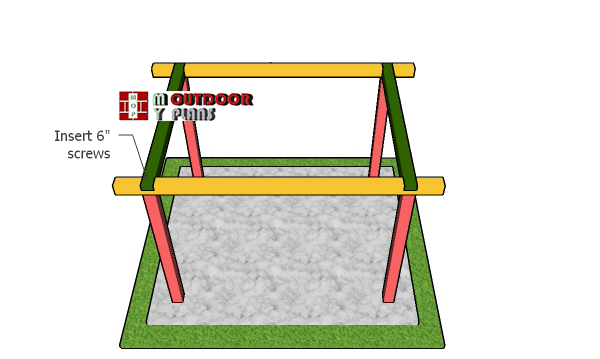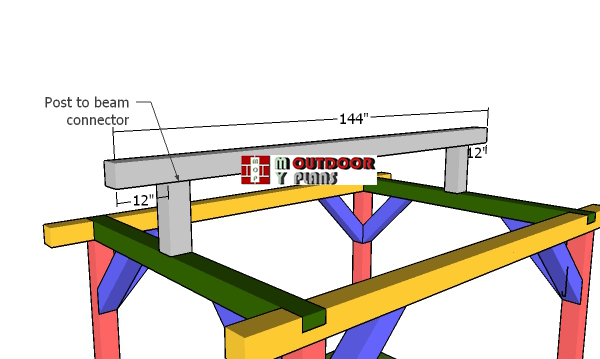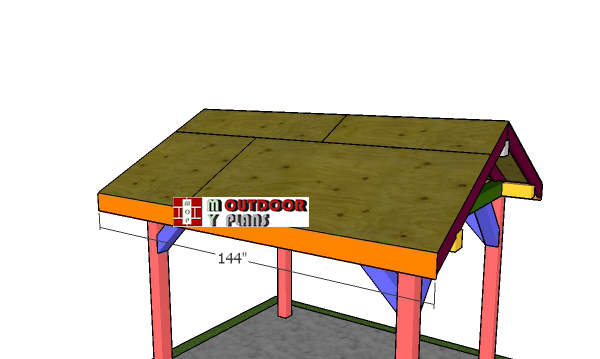This step by step diy woodworking project is about a 8×10 backyard pavilion plans. A small pavilion is ideal for a bbq or pizza oven. This pavilion features a strong wooden frame and a gable roof. I have designed this shelter to protect a 80 sq ft area and help you save money. This pavilion is built on a sturdy 6×6 framing and it features 2×6 rafters. My plans come with a complete cut / shopping list and they are PDF downloads and Print friendly. Take a look over the rest of our woodworking plans, if you want to get more building inspiration. Premium Plans for this project available in the Shop.
When buying the lumber, you should select the planks with great care, making sure they are straight and without any visible flaws (cracks, knots, twists, decay). Investing in cedar or other weather resistant lumber is a good idea, as it will pay off on the long run. Use a spirit level to plumb and align the components, before inserting the galvanized screws, otherwise the project won’t have a symmetrical look. If you have all the materials and tools required for the project, you could get the job done in about a day. See all my Premium Plans HERE.
Projects made from these plans
8×10 Outdoor Pavilion – Free DIY Plans

Building-a-8×10-gable-pavilion-diy
Cut + Shopping Lists
- A – 4 pieces of 6×6 lumber – 84″ long POSTS
- B – 2 pieces of 6×6 lumber – 144″ long TOP PLATES
- C – 2 pieces of 6×6 lumber – 96″ long CROSS PLATES
- D – 10 pieces of 6×6 lumber – 32″ long BRACES
- E – 2 pieces of 6×6 lumber – 17 1/4″ long, 1 piece – 144″ long RIDGE BEAM
- F – 20 pieces of 2×6 lumber – 72″ long RAFTERS
- G – 2 pieces of 1/2″ plywood – 48″x96″ long, 2 pieces – 48″x48″ long, 2 pieces – 21 1/4″x64″ long, 2 pieces – 21 1/4″x80″ long ROOF SHEETS
- H – 2 pieces of 1×8 lumber – 144″ long, 4 pieces – 73 3/4″ long TRIMS
- H – 150 sq of tar paper, 150 sq ft of asphalt shingles ROOFING
- 8 pieces of 6×6 lumber – 8′
- 5 pieces of 6×6 lumber – 12 ft
- 10 pieces of 2×6 lumber – 12′
- 2 pieces of 1×8 lumber – 12′
- 4 pieces of 1×8 lumber – 8′
- 5 pieces of 1/2″ plywood – 4’x8′
- 150 sq of tar paper, 150 sq ft of asphalt shingles
- 40 pieces of 5 1/2″ screws, 16 pieces of 6″ screws
- 500 pieces of 1 5/8″ screws
- wood glue, stain/paint
- post hole digger
- 4 pieces of post anchors
- 4 pieces of beam to post connectors
- 1 box of structural screws for connectors
Tools
![]() Chalk line, tape measure, spirit level, carpentry pencil
Chalk line, tape measure, spirit level, carpentry pencil
Time
Related
How to build a 8×10 pavilion

Laying-out-the-posts—8×10-pavilion
Determining the location for the pavilion is essential, as you have to comply with the local building codes. Make sure the surface is level and remove the vegetation layer. You can build this pavilion to an already existing concrete slab, or you can start from scratch.
Layout the posts for the 8×10 pavilion. Use batter boards and string to determine the location of the posts. Apply the 3-4-5 rule to every corner of the pavilion, so you make sure they are right angled. Moreover measure the diagonals and make sure they are equal.

Setting the posts in concrete
You can set the posts in concrete or you can pour footings and attach the wooden posts into place with an anchor. Dig 2-3′ deep in the ground and 16″ in diameter and pour the footings. Set the anchors and then attach the posts with temporarily braces. Insert the screws through the anchors into the post. Plumb the posts with a spirit level before locking the posts with the braces.
Building the frame of the pavilion

Top-plates—wooden-pavilion
Next,, use 6×6 lumber for the top plates. Mark the cut lines to the beams and then use a circular saw to make the notches to the beams. Make parallel cuts and then use a hammer to remove the excess. Smooth the recess with a chisel and sandpaper.

Fitting-the-side-top-plates
Fit the side plates to the top of the pavilion, as shown in the diagram. Notice the 12″ side overhangs and then lock the beams to the posts with 6″ screws. Insert at least 2 screws for each joint, and drill pilot holes before inserting the screws.

Fitting-the-crossbeams
Fit the crossbeams to the top of the rectangular pavilion. Drill pilot holes and insert 6″ screws to lock the beams to the frame of the pavilion.

Fitting-the-braces-for-the-pavilion
Use 6×6 lumber for the braces. Make 45 degree cuts to both ends of the braces. Double check if the posts are plumb and if the corners are square. Secure the braces into place with 5 1/2″ screws, after drilling pilot holes. These braces will really enhance the rigidity of the pavilion.
Building the roof for the pavilion

Supports-for-ridge-beam
Next, use 6×6 lumber for the ridge beam supports. Set the supports to the middle of the top plates. Insert 1 1/2″ structural screws and use post to beam connectors to lock the supports into place tightly.

Fitting-the-ridge-beam
Use 6×6 lumber for the ridge beam. Fit the top ridge beam to the top of the supports. The ridge beam should have 12″ overhang on both sides. Use post to beam connectors to reinforce the joints.

Ridge-beam-braces
Last but not least, you need to attach the 6×6 braces to the structure of the pavilion, so you can enhance the rigidity. Cut both both ends of the braces at 45 degrees and then secure them into place tightly, with 5 1/2″ screws.

Rafters—gable-pavilion
Use 2×6 lumber for the rafters. Remember that you have to use a miter saw to make 26.5 degree cuts at both ends of the beams. In addition, mark the cut lines on the rafters and make the birdmouth cuts with a circular saw. The roof pitch for this project is 6:12.

Fitting-the-rafters—8×10-gable-roof
Fit the rafters to the top of the pavilion, every 16″ on center. Use the rafter ties to lock the rafters to the framing of the pavilion.

Roof-sheets—gable-pavilion
Use 1/2″ plywood for the roof of the gable pavilion. Cut the sheets at the right dimensions and lay them over the roof structure, following the pattern described in the shed diagram. Leave no gaps between the sheets and insert 1 5/8″ screws, every 8″ along the framing.
Finishing touches

Fitting-the-side-trims
Use 1×8 lumber for the roof trims. First, attach the trims to the sides of the backyard pavilion. Use 2″ nails to secure the trims into place.

Gable-trims—wooden-pavilion
Similarly, use 1×8 lumber for the front and back roof trims. Make the 26.5 degree angle cuts to the trims and then secure them into place tightly with 2″ nails.

Fitting-the-roofing—8×10-gable-pavilion
Cover the roof of the pavilion with tar paper and then install the asphalt shingles. Use drip edges to make sure the roof is waterproof.

8×10 pavilion – dimensions
This diagram shows you all the dimensions for this backyard pavilion. As you can see in the image, the overall height is under 10 ft.

How to build a 8×10 gable pavilion
Make sure you read the local building codes and make modifications to suit your local meteorological conditions (strong winds, snow load).

8×10-Pavilion-Plans—front-view
Fill the holes with wood putty and let them dry out for a few hours. Smooth the surface with 100-220 grit sandpaper and remove the residues with a damp cloth.
Top Tip: Apply a few coats of paint or stain to the components, to enhance the look of the project. Make sure you take a look over the rest of my pergola/gazebo/pavilion plans HERE. See all my free woodworking plans (over 1000) HERE. Premium Plans for this project available in the Shop.
This woodworking project was about 8×10 backyard pavilion plans free. If you want to see more outdoor plans, check out the rest of our step by step projects and follow the instructions to obtain a professional result. Feel free to SHARE my plans with your friends.
